Impact of Self-Compacting Concrete Admixtures on Frost Resistance and Compressive Strength—Commensurability of Frost Resistance Criteria
Abstract
:1. Introduction
2. Materials and Tests Methodology
2.1. Tested Concretes
2.2. Measures and Criteria of Concrete Internal Frost Resistance
2.3. Methodology
3. Tests Results
4. Discussion of the Results
4.1. The Comparison of Test Results of SCC Mix with the Addition of SP1 or SP2 Superplasticisers
- -
- -
- No loss in mass of the specimens was found;
- -
- There was no decrease in strength (3% increase was obtained)—Table 7;
- -
- -
- No weight loss of the specimens occurred.
4.2. The Comparison of the Influence of AFA and VMA Admixtures on Air-Entrained SCC as a Side Effect of SP1
- -
- There was no decrease in strength (a slight increase was obtained)—Table 7;
- -
- -
- The weight loss of the specimens was less than 1%.
- -
- There were slight drops in strength, instead of equally slight increases;
- -
- RDMUPPT values were higher—Figure 15.
4.3. VMA and AEA Impact in Case of Non-Air-Entrained SCC
- -
- Very high loss of compressive strength (49.3 and 32.6%), which excluded the frost resistance of concrete, turned into only a few percent decrease in strength or even a slight increase in strength after the frost resistance test—Table 7;
- -
- The trend for a continuous decrease in the value of RDMUPPT obtained for concretes without AEA changed into the opposite tendency, i.e., a continuous, although slight, increase in RDMUPPT—Figure 16.
- -
- By 18.7 N/mm2 between S2 and S2.A concrete;
- -
- By 8.0 N/mm2 between S2.V and S2.A.V concrete.
- -
- Lower by 14.3 N/mm2 in the cases of concretes S2 and S2.A;
- -
- Almost identical for concretes S2.V and S2.A.V.
- -
- The relative increase in strength of S2.A air-entrained concrete was 31.1%, while for S2 concrete without AEA, it was 17.4%;
- -
- The relative increase in strength of S2.A.V air-entrained concrete was 11.5%, while for S2.V concrete without air-entraining admixture was 4.4%.
4.4. Directions of Future Works
5. Conclusions
5.1. The Influence of Chemical Admixtures on Frost Resistance and Strength of Concrete
- The superplasticizer based on polycarboxylic ethers unintentionally caused air-entraining to the concrete mix to about 8%. This resulted in the frost resistance of concrete after 300 freeze–thaw cycles. A potentially dangerous side effect of air entrainment was about 17% lower compressive strength compared to concrete with the same base composition, which contained a superplasticiser and did not demonstrate the above-mentioned negative effect.
- The addition of AFA to the unintentionally air-entrained concrete caused a decrease in the amount of air by about 5% in the concrete mix and about 2.5% of air voids in hardened concrete. The concrete with AFA still met all the frost resistance criteria used in tests. The decrease in air content did not result in the expected increase in the compressive strength. This effect may be due to the negative effect of the AFA admixture components (fatty alcohol ester) on cement hydration.
- The air-entrained concrete had the expected positive and negative effects. The air content increased to 5% in concrete mix and to near 4% in hardened concrete. According to the criterion of the change in compressive strength, the air entrainment of concrete mixtures caused the frost resistance of concrete, which was not frost-resistant. The negative effect was the 8–20% reduction in the compressive strength.
- The effect of VMA admixture was not evident. The influence of VMA in unintentionally and intentionally air-entrained concrete on internal frost resistance and compressive strength determined after 28 days of curing was insignificant. The influence on the compressive strength after 128 days of curing in non-air-entrained concrete was statistically significant.
5.2. Commensurability of the Criteria for Assessing the Internal Frost Resistance of Concrete
- In the case of non-air-entrained concretes, the obtained frost resistance indexes indicated both a frost resistance and lack of frost resistance, depending on the assessment method and the corresponding criterion. The mentioned concretes did not meet the criterion of permissible loss of compressive strength; the decrease in strength after 300 cycles of the frost resistance test reached 50%.
- The indicator in the form of the relative dynamic modulus of elasticity correctly described the damage caused by the impact of low temperatures only qualitatively. In the case of non-air-entrained concretes, a constant decrease in the value of RDMUPTT was obtained, but the decrease was disproportionately low concerning the loss of concrete strength.
- There was no loss in weight of the non-air-entrained concrete specimens, despite a large reduction in strength. The criterion of sample mass change should only determine the resistance to surface damage caused by frost.
- Internal frost resistance, understood as resistance to degradation of the internal structure of concrete, as shown in this research, is best assessed using destructive methods. The decisive criteria for internal frost resistance should be the change in concrete strength and/or the static modulus of elasticity, which directly reflect the mechanical damage of concrete.
Author Contributions
Funding
Institutional Review Board Statement
Informed Consent Statement
Data Availability Statement
Conflicts of Interest
References
- Shmidt, W. Mode of operation of polysaccharide stabilising agent in cement based systems and interactions with superplasticisers. In Proceedings of the First International Conference on Bio-based Building Materials, Clermont-Ferrand, France, 22–24 June 2015; pp. 100–106. [Google Scholar]
- Prakahs, N.; Santhanam, M. Measuring, Monitoring and Modeling Concrete Properties; Springer: Berlin, Germany, 2006; pp. 449–454. [Google Scholar]
- Skripkiūnas, G.; Nagrockienė, D.; Girskas, G.; Vaičienė, M.; Baranauskaitė, E. The cement type effect on freeze-thaw and deicing salt resistance of concrete. Procedia Eng. 2013, 57, 1045–1051. [Google Scholar] [CrossRef] [Green Version]
- Karakoç, M.B.; Demirboğa, R.; Türkmen, İ.; Can, İ. Modeling with ANN and effect of pumice aggregate and air entrainment on the freeze-thaw durabilities of HSC. Constr. Build. Mater. 2011, 25, 4241–4249. [Google Scholar] [CrossRef]
- Molero, M.; Aparicio, S.; Al-Assadi, G.; Casati, M.J.; Hernadéz, M.G.; Anaya, J.J. Evaluation of freeze-thaw damage in concrete by ultrasonic imaging. NDT E Int. 2012, 52, 86–94. [Google Scholar] [CrossRef] [Green Version]
- Moradllo, M.K.; Qiao, C.; Ghantous, R.M.; Zaw, M.; Hall, H.; Ley, M.T.; Weiss, W.J. Quantifying the freeze-thaw performance of air-entrained concrete using the time to reach critical saturation modelling approach. Cem. Concr. Compos. 2020, 106, 103479. [Google Scholar] [CrossRef]
- Felice, R.V. Frost Resistance of Modern Air-Entrained Concrete; Oklahoma State University: Stillwater, OK, USA, 2010.
- EN 934-1. Admixtures for Concrete, Mortar and Grout—Part 1: Common Requirements. Available online: https://standards.cen.eu/dyn/www/f?p=204:110:0::::FSP_PROJECT,FSP_ORG_ID:28610,6087&cs=16A2E3045718E12231BBB61F3EE091DF0 (accessed on 27 May 2021).
- EN 934-2. Admixtures for Concrete, Mortar and Grout—Part 2: Concrete Admixtures—Definitions, Requirements, Conformity, Marking and Labelling. Available online: https://standards.cen.eu/dyn/www/f?p=204:110:0::::FSP_PROJECT,FSP_ORG_ID:38487,6087&cs=1B7CD840D6FB3ABFB3080B558C910CF78 (accessed on 27 May 2021).
- Sakai, E.; Kasuga, T.; Sugiyama, T.; Asaga, K.; Daimon, M. Influence of superplasticizers on the hydratation of cement and the pore structure of hardened cement. Cem. Concr. Res. 2006, 36, 2049–2053. [Google Scholar] [CrossRef]
- Łaźniewska-Piekarczyk, B. The influence of admixtures type on the air-void parameters of non-air-entrained and air-entrained high performance SCC. Constr. Build. Mater. 2013, 41, 109–124. [Google Scholar] [CrossRef]
- Nowak-Michta, A. Influence of superplasticizer on porosity structures in hardened concretes. Procedia Eng. 2015, 108, 262–269. [Google Scholar] [CrossRef] [Green Version]
- Barfield, M.; Ghafoori, N. Air-entrained self-consolidating concrete: A study of admixture sources. Constr. Build. Mater. 2012, 26, 490–496. [Google Scholar] [CrossRef]
- Netinger Grubeša, I.; Marković, B.; Vračević, M.; Tunkiewicz, M.; Szenti, I.; Kukovecz, Á. Pore structure as a response to the freeze/thaw resistance of mortars. Materials 2019, 12, 3196. [Google Scholar] [CrossRef] [Green Version]
- Sonebi, M.; Schmidt, W.; Khatib, J. Influence of the type of viscosity-modifying admixtures and metakaolin on the rheology of grouts. Chem. Mater. Res. 2013, 5, 106–111. [Google Scholar]
- Sonebi, M. Rheology of grouts containing ground granulated blastfurnace slag and viscosity enhancing admixture. In Proceedings of the Second International Conference on Sustainable Construction Materials and Technologies, Università Politecnica delle Marche, Ancona, Italy, 28–30 June 2010. [Google Scholar]
- Khayat, K.H. Viscosity-enhancing admixtures for cement-based materials—An overview. Cem. Concr. Compos. 1998, 20, 171–188. [Google Scholar] [CrossRef]
- Grabiec, A.M. Influence of viscosity modifying agent on some rheological properties, segregation resistance and compressive strength of self-compacting concrete. J. Civ. Eng. Manag. 2013, 19, 1–8. [Google Scholar] [CrossRef]
- Panesar, D.K.; Shindman, B. Elastic properties of self consolidating concrete. Constr. Build. Mater. 2011, 25, 3334–3344. [Google Scholar] [CrossRef]
- Umar, A.; Al-Tamimi, A. Influence of Viscosity Modifying Admixture (VMA) on the properties of SCC produced using locally supplied materials in Bahrain. Jordan J. Civ. Eng. 2011, 5, 32–49. [Google Scholar]
- Qui, L.; Gao, X.; Ye, H.; Chen, T. Effects of anti-foaming on properties of ultra-high performance concrete. Rom. J. Mater. 2018, 48, 222–228. [Google Scholar]
- Huang, H.; Gao, X.; Jia, D. Effects of rheological performance antifoaming admixture and mixing procedure on air bubbles and strength of UHPC. J. Mater. Civ. Eng. 2019, 31. [Google Scholar] [CrossRef]
- Łaźniewska-Piekarczyk, B. The interactions between anti-foaming and superplasticizing admixtures and their consequences for properties of self-compacting mortar and concrete. Archit. Civ. Eng. Environ. 2019, 4, 61–71. [Google Scholar] [CrossRef] [Green Version]
- Korhonen, C. Effect of High Doses of Chemical Admixtures on the Freeze-Thaw Durability of Portland Cement Concrete; Technical Report ERDC/CRREL TR-02-5; US Army Corps of Engineers, Engineer Research and Development Center: Washington, DC, USA, 2002.
- Łaźniewska-Piekarczyk, B. Examining the possibility to estimate the influence of admixtures on pore structure of self-compacting concrete using the air void analyzer. Constr. Build. Mater. 2013, 41, 374–387. [Google Scholar] [CrossRef]
- EN 12350-8. Testing Fresh Concrete. Part 8: Self-Compacting Concrete. Slump-Flow Test. Available online: https://standards.cen.eu/dyn/www/f?p=204:110:0::::FSP_PROJECT,FSP_ORG_ID:64406,6087&cs=185559300D2E706B8FF1FD21187A77D8E (accessed on 27 May 2021).
- EN 12350-7. Testing Fresh Concrete. Part 7: Air Content. Pressure Methods. Available online: https://standards.cen.eu/dyn/www/f?p=204:110:0::::FSP_PROJECT,FSP_ORG_ID:64408,6087&cs=1C62F164EBD96976CACBA9CF3DB44C477 (accessed on 27 May 2021).
- Hanjari, K.Z.; Utgenannt, P.; Lundgren, K. Experimental study of the material and bond properties of frost-damaged concrete. Cem. Concr. Res. 2011, 41, 244–254. [Google Scholar] [CrossRef] [Green Version]
- Cai, H.; Liu, X. Freeze-thaw durability of concrete: Ice formation process in pores. Cem. Concr. Res. 1998, 28, 1281–1287. [Google Scholar] [CrossRef]
- ASTM C 215-02. Standard Test Method for Fundamental Transverse, Longitudinal, and Torsional Resonant Frequencies of Concrete Specimens. Available online: https://www.astm.org/DATABASE.CART/HISTORICAL/C215-02.htm (accessed on 27 May 2021).
- Hamoush, S.; Picornel-Darder, M.; Abu-Lebdeh, T.; Mohamed, A. Freezing and thawing of very high strength concrete. Am. J. Eng. Appl. Sci. 2011, 4, 42–51. [Google Scholar] [CrossRef] [Green Version]
- Vaitkevičius, V.; Šerelis, E.; Rudžionis, Ž. Non-destructive testing of ultra-high performance concrete to evaluate freeze-thaw resistance. Mechanika 2012, 18, 164–169. [Google Scholar] [CrossRef] [Green Version]
- Kocáb, D.; Kucharczyková, B.; Danĕk, P.; Vymazal, T.; Hanuš, P.; Halamová, R. Destructive and non-destructive assessment of the frost resistance of concrete with different aggregate, International Conference Building Materials, Product and Technologies. Iop Conf. Ser. Mater. Sci. Eng. 2018, 379, 012022. [Google Scholar] [CrossRef]
- CEN/TR 15177:2006. Testing the Freeze-Thaw Resistance of Concrete—Internal Structure Damage. Available online: https://standards.cen.eu/dyn/www/f?p=204:110:0::::FSP_PROJECT,FSP_ORG_ID:24916,6035&cs=194EE28C07D3CA48223BE9EDC1B6DA081 (accessed on 27 May 2021).
- Ӧz, H.Ӧ.; Yücel, H.E.; Güneş, M. Freeze-thaw resistance of self compacting concrete incorporating basic pumice. Int. J. Theor. Appl. Mech. 2016, 1, 285–291. [Google Scholar]
- Pospíchal, O.; Kucharczyková, B.; Misák, P.; Vymazal, T. Freeze-thaw resistance of concrete with porous aggregate. Procedia Eng. 2010, 2, 521–529. [Google Scholar] [CrossRef]
- ASTM C 666/C 666M—15 Standard Test Method for Resistance of Concrete to Rapid Freezing and Thawing. Available online: https://www.astm.org/Standards/C666.htm (accessed on 27 May 2021).
- Wu, H.; Liu, Z.; Sun, B.; Yin, J. Experimental investigation on freeze-thaw durability of Portland cement previous concrete (PCPC). Constr. Build. Mater. 2016, 117, 63–71. [Google Scholar] [CrossRef]
- Nakamura, T.; Horiguchi, T.; Shimura, K. Frost resistance of pervious concrete with different freezing and thawing tests. In Proceedings of the 11DBMC International Conference on Durability of Building Materials and Components, Istanbul, Turkey, 11–14 May 2008. [Google Scholar]
- Yu, H.; Ma, H.; Yan, K. An equation for determining freeze-thaw fatigue damage in concrete and a model for predicting the service life. Constr. Build. Mater. 2017, 137, 104–116. [Google Scholar] [CrossRef]
- Zhang, D.; Mao, M.; Zhang, S.; Yang, Q. Influence of stress and high temperature on the freeze-thaw resistance of concrete with fly ash as fine aggregate. Constr. Build. Mater. 2019, 229, 116845. [Google Scholar] [CrossRef]
- Tang, L.; Petresson, P.E. Test-freeze/thaw resistance of concrete-internal deterioration. Mater. Struct. 2004, 37, 754–759. [Google Scholar] [CrossRef]
- Wang, X.; Wu, Y.; Shen, X.; Wang, H.; Liu, S.; Yan, C. An experimental study of a freeze-thaw damage model of natural pumice concrete. Powder Technol. 2018, 339, 651–658. [Google Scholar] [CrossRef]
- Berto, L.; Saetta, A.; Talledo, D. Constitutive model pf concrete damage by freeze-thaw action for evaluation of structural performance of RC elements. Constr. Build. Mater. 2015, 98, 559–569. [Google Scholar] [CrossRef]
- PN-B-06265 Beton. Wymagania, Właściwości, Produkcja i Zgodność. Krajowe Uzupełnienie PN-EN 206+A1:2016-12 (Concrete. Specification, Performance, Production and Conformity. National Annex to PN-EN 206+A1:2016-12). Available online: https://wiedza.pkn.pl/wyszukiwarka-norm?p_auth=QIYIDqx3&p_p_id=searchstandards_WAR_p4scustomerpknzwnelsearchstandardsportlet&p_p_lifecycle=1&p_p_state=normal&p_p_mode=view&p_p_col_id=column-1&p_p_col_count=1&_searchstandards_WAR_p4scustomerpknzwnelsearchstandardsportlet_standardNumber=PN-B-06265%3A2018-10P&_searchstandards_WAR_p4scustomerpknzwnelsearchstandardsportlet_javax.portlet.action=showStandardDetailsAction (accessed on 27 May 2021).
- Huai-shuai, S.; Yu-pu, S. Behavior of air-entrained concrete under the compression with constant confined stress after freeze-thaw cycles. Cem. Concr. Compos. 2008, 30, 854–860. [Google Scholar]
- Dvorkin, L. Design estimation of concrete frost resistance. Constr. Build. Mater. 2019, 211, 779–784. [Google Scholar] [CrossRef]
- EN 480-11. Admixtures for Concrete, Mortar and Grout. Test Methods. Part 11: Determination of Air Void Characteristics in Hardened Concrete. Available online: https://standards.cen.eu/dyn/www/f?p=204:110:0::::FSP_PROJECT,FSP_ORG_ID:24333,6087&cs=1030A27CA74CB48D1DD96DF319008BC00 (accessed on 27 May 2021).
- Łaźniewska-Piekarczyk, B. The influence of chemical admixtures on cement hydratation and mixture properties of very high performance self-compacting concrete. Constr. Build. Mater. 2013, 49, 643–662. [Google Scholar] [CrossRef]
- Tuyan, M.; Mardani-Aghabaglou, A.; Ramyar, K. Freeze-thaw resistance, mechanical and transport properties of self-consolidating concrete incorporating coarse recycled concrete aggregate. Mater. Des. 2014, 53, 983–991. [Google Scholar] [CrossRef]
- EN 13791:2019. Assessment of In-Situ Compressive Strength in Structures and Precast Concrete Components. Available online: https://standards.cen.eu/dyn/www/f?p=204:110:0::::FSP_PROJECT,FSP_ORG_ID:38122,6087&cs=1AC99409BB19D1E80EC4DAC2B652BF2F6 (accessed on 27 May 2021).
- Guo, S.; Dai, Q.; Sun, X.; Sun, Y.; Liu, Z. Ultrasonic techniques for air void size distribution and property evaluation in both early-age and hardened concrete samples. Appl. Sci. 2017, 7, 290. [Google Scholar] [CrossRef] [Green Version]
- Persson, B. Internal frost resistance and salt frost scaling of self-compacting concrete. Cem. Concr. Res. 2003, 33, 373–379. [Google Scholar] [CrossRef]
- Garbalińska, H.; Wygocka, A. Microstructure modification of cement mortars: Effect on capillarity and frost-resistance. Constr. Build. Mater. 2014, 51, 258–266. [Google Scholar] [CrossRef]
- Shang, H.; Song, Y.; Ou, J. Beahavior of air-entrained concrete after freeze-thaw cycles. Acta Mechanica Solida Sinica 2009, 22, 261–266. [Google Scholar] [CrossRef]



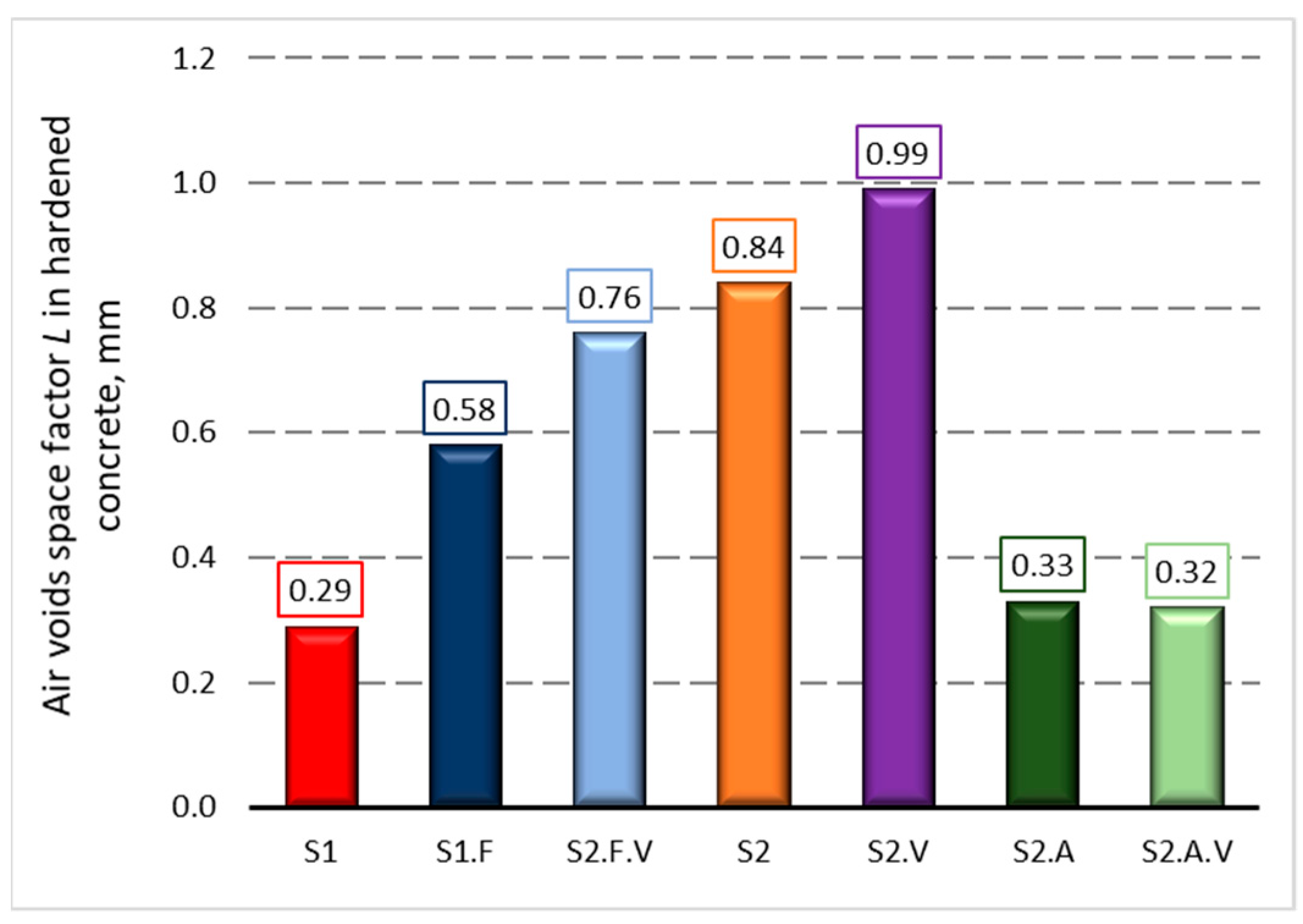
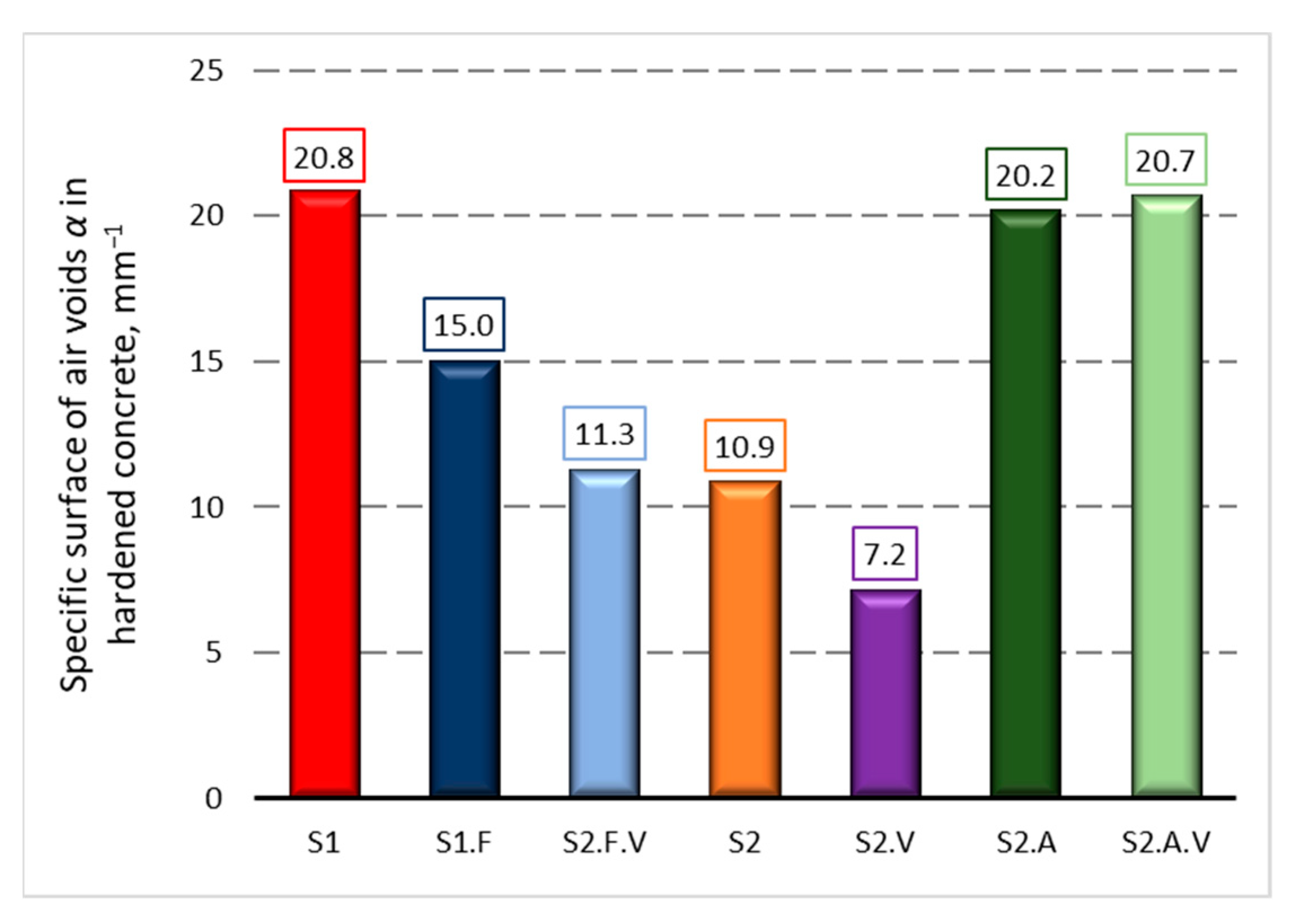

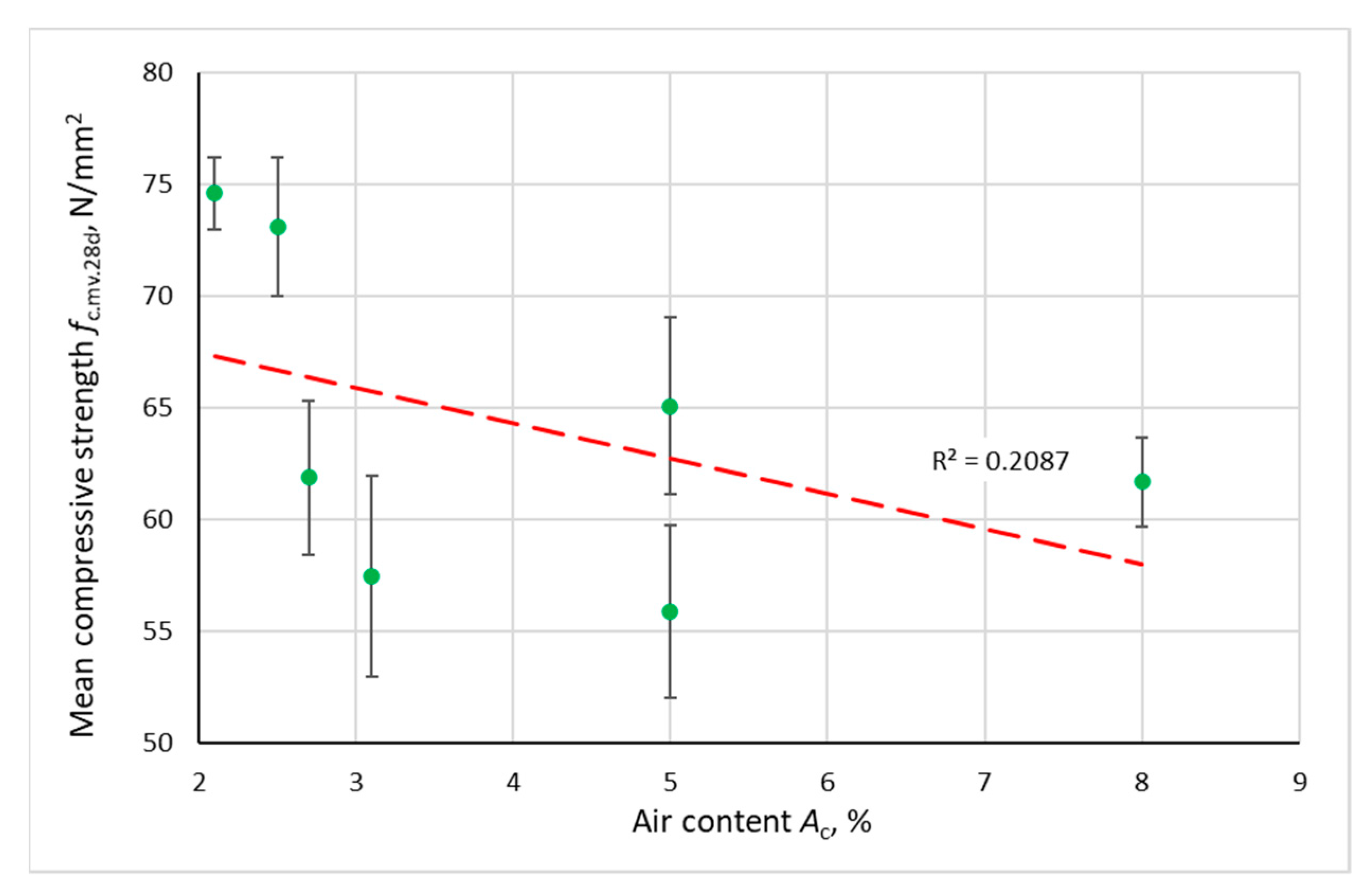

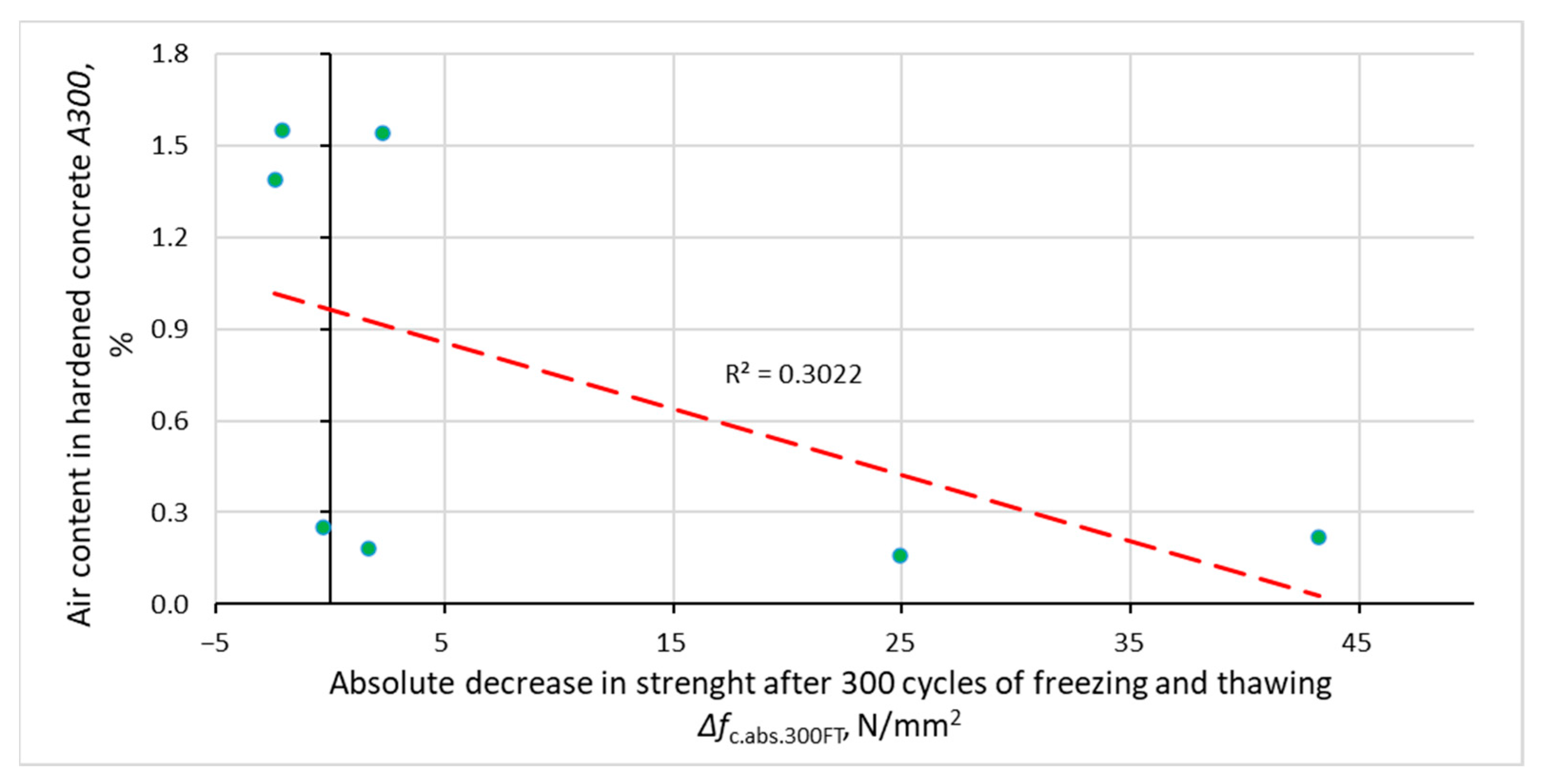
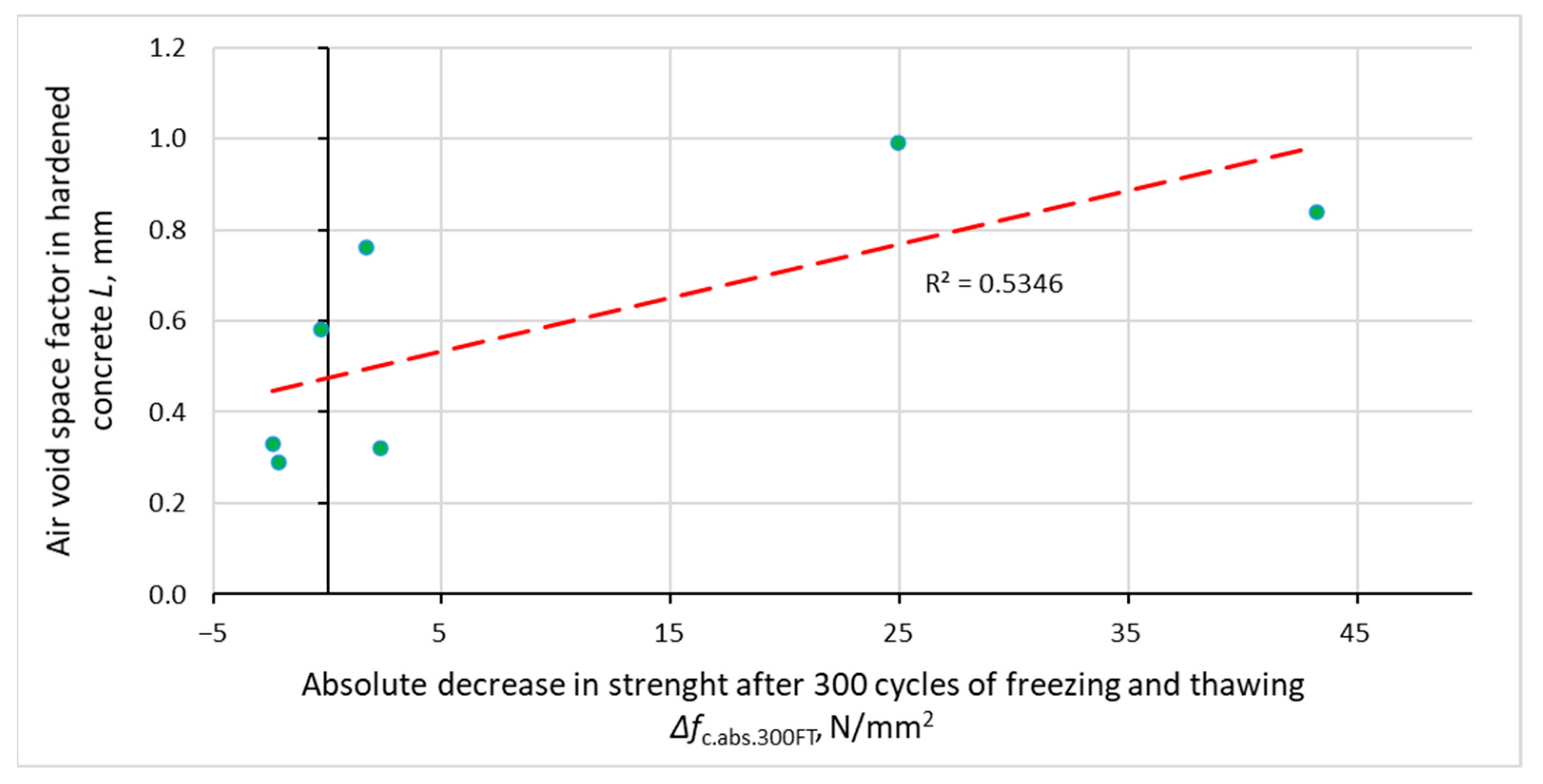
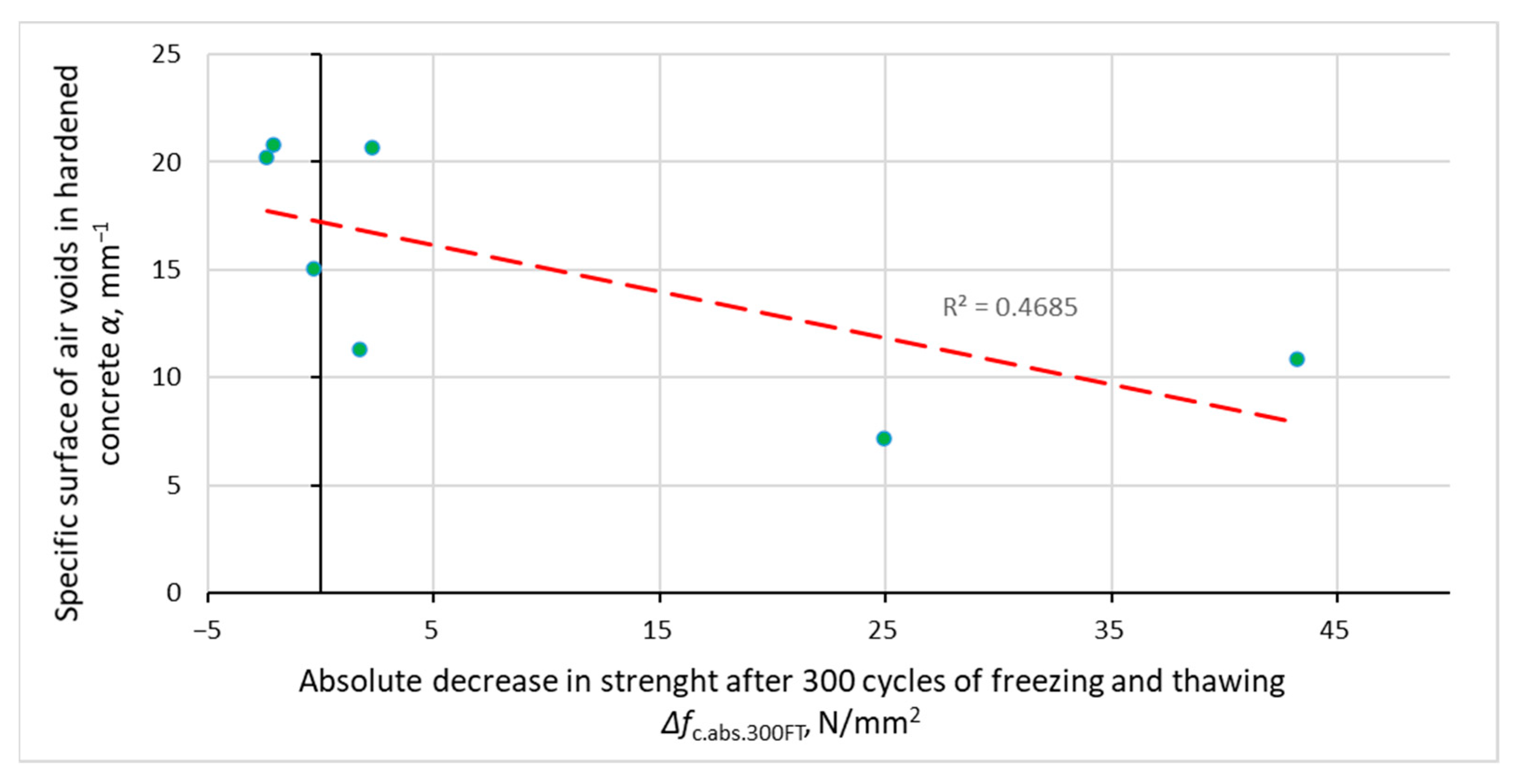

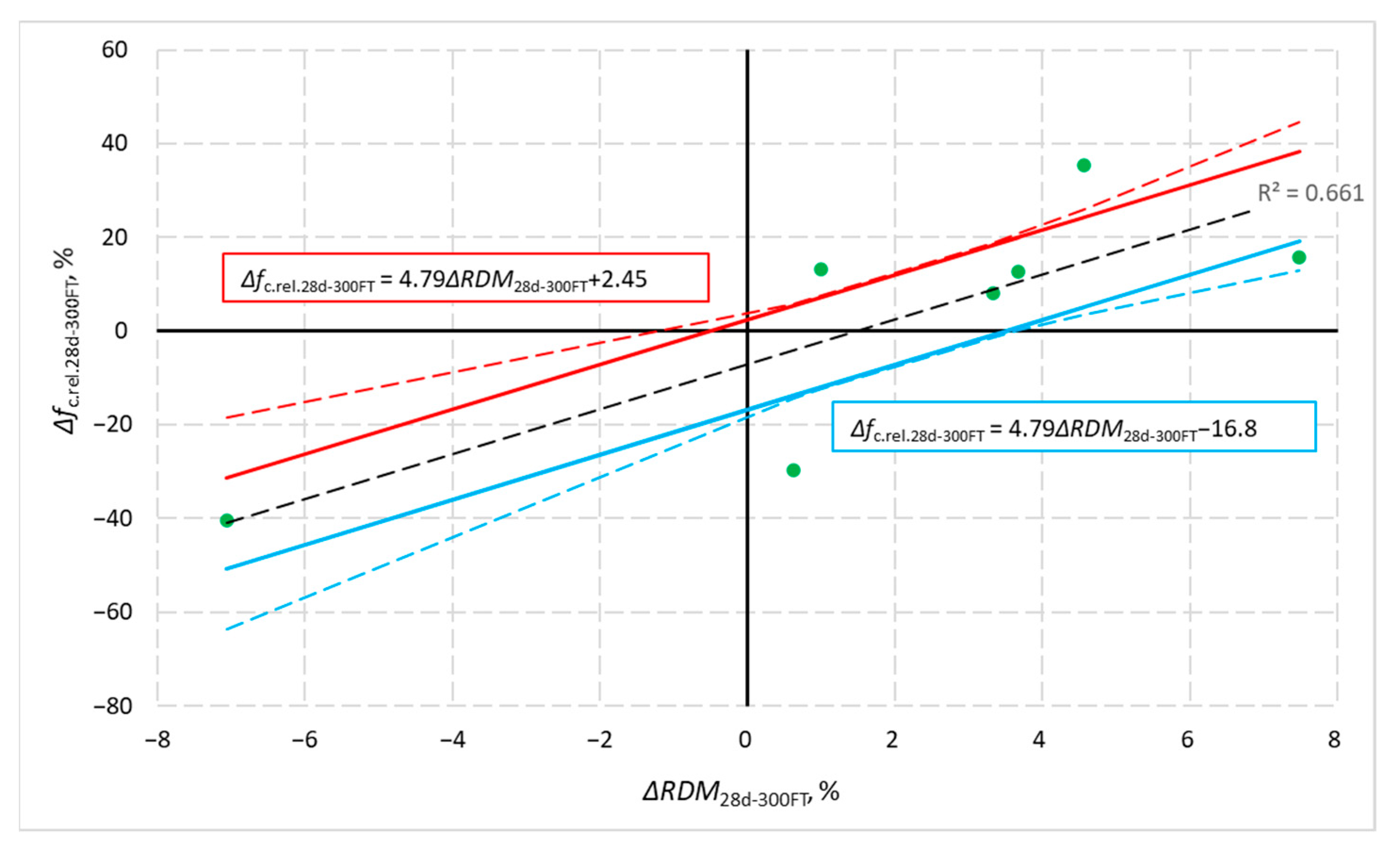

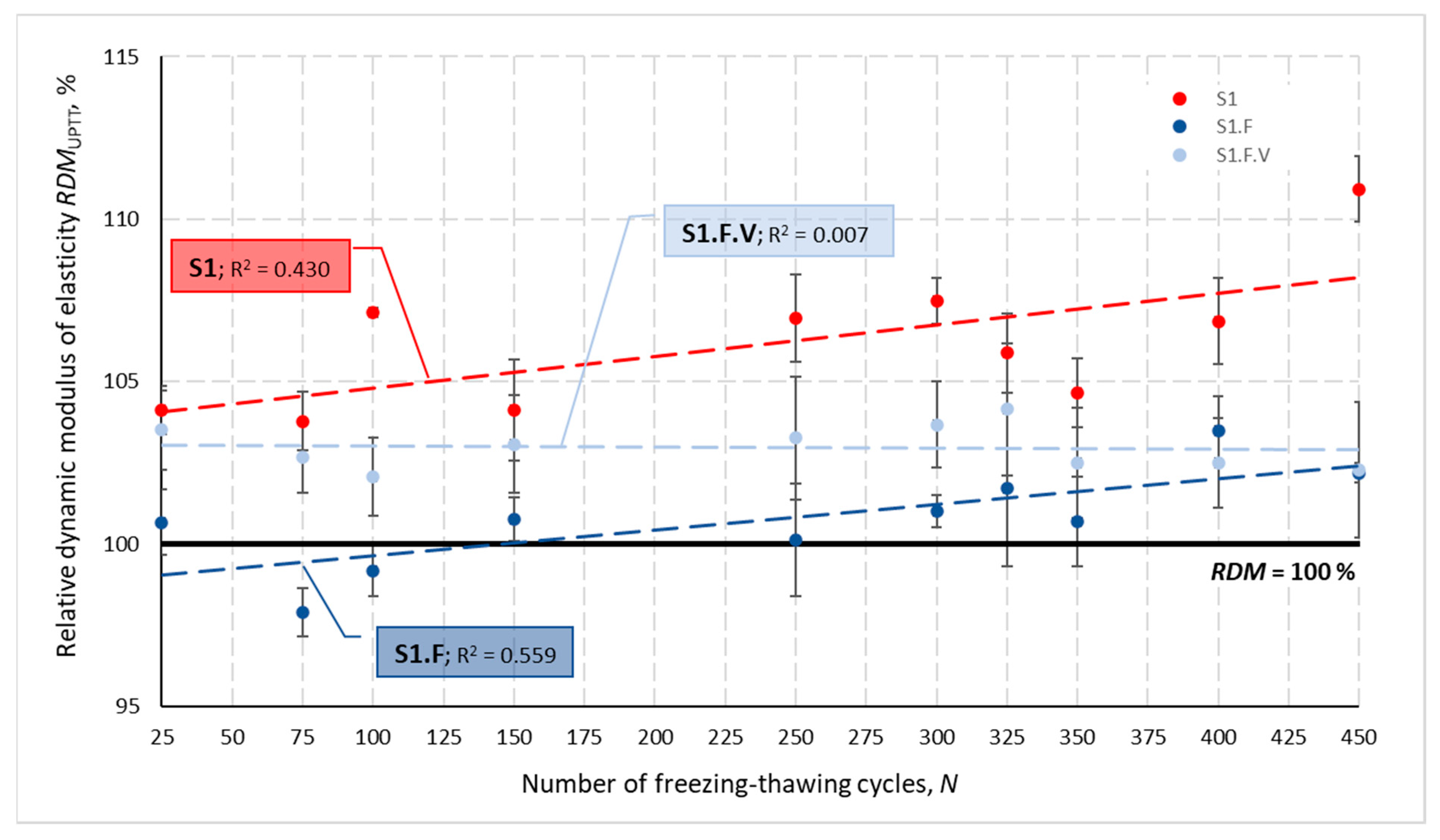

| Cement CEM II B-S 32.5 R (C), kg/m3 | Limestone Powder (LP), kg/m3 | w/c | w/b w/(C+LP) | Sand 0–2 mm, kg/m3 | Gravel 2–8 mm, kg/m3 | Volume of Cement Paste, % |
|---|---|---|---|---|---|---|
| 442.4 | 190.0 | 0.45 | 0.31 | 693.2 | 866.5 | 41.0 |
| Concrete Symbol | Admixtures (a) | The Effect of Admixtures |
|---|---|---|
| S1 | SP.1 „air-entraining” | Increasing the degree of fluidity and unintentional air-entraining |
| S1.F | SP.1 + AFA | Increasing the degree of fluidity and elimination of unintentional air-entraining due to the action of SP.1 |
| S1.F.V | SP.1 + AFA + VMA | Increasing the degree of fluidity, elimination of unintentional air-entraining and preventing segregation due to the action of SP.1 and AFA |
| S2 | SP.2 | Increasing the degree of fluidity |
| S2.V | SP.2 + VMA | Increasing the degree of fluidity and preventing segregation due to the action of SP.2 |
| S2.A | SP.2 + AEA | Increasing the degree of fluidity and intentional air-entraining |
| S2.A.V | SP.2 + AEA + VMA | Increasing the degree of fluidity, intentional air-entraining and preventing segregation due to the action of SP.2 and AEA |
| Concrete Symbol | Type of Admixture | ||||
|---|---|---|---|---|---|
| SP1 | SP2 | AFA | VMA | AEA | |
| S1 | 0.67 | - | - | - | - |
| S1.F | 0.67 | - | 1.80 | - | - |
| S1.F.V | 0.67 | - | 1.80 | 0.25 | - |
| S2 | - | 1.33 | - | - | - |
| S2.V | - | 1.53 | - | 0.25 | - |
| S2.A | - | 1.16 | - | - | 0.04 |
| S2.A.V | - | 1.51 | - | 0.25 | 0.08 |
| Concrete Symbol | Flow Spread D, mm | Flow Time T500, s | Air Content Ac, % |
|---|---|---|---|
| S1 | 730 | 3 | 8.0 |
| S1.F | 705 | 2 | 2.7 |
| S1.F.V | 710 | 5 | 3.1 |
| S2 | 715 | 2 | 2.1 |
| S2.V | 710 | 4 | 2.5 |
| S2.A | 640 | 3 | 5.0 |
| S2.A.V | 690 | 4 | 5.0 (a) |
| Concrete Symbol | Δmrel, % (a) |
|---|---|
| S1 | 0.00 (-) |
| S1.F | 0.89 (7.25) |
| S1.F.V | 0.52 (10.5) |
| S2 | 0.00 (-) |
| S2.V | 0.00 (-) |
| S2.A | 0.03 (6.25) |
| S2.A.V | 0.10 (10.0) |
| Concrete Symbol | Mean Compressive Strength of Concrete (a) | ||
|---|---|---|---|
| not Frozen after | after 300 Cycles of Freezing and Thawing fc.mv.300FT, N/mm2 | ||
| 28 days fc.mv.28d, N/mm2 | 128 days fc.mv.128d, N/mm2 | ||
| S1 | 61.7 (3.22) | 69.4 (4.86) | 71.5 (5.46) |
| S1.F | 61.9 (5.57) | 69.7 (6.19) | 70.0 (6.48) |
| S1.F.V | 57.5 (7.81) | 66.5 (9.94) | 64.8 (8.61) |
| S2 | 74.6 (2.14) | 87.6 (4.40) | 44.4 (9.48) |
| S2.V | 73.1 (4.24) | 76.3 (6.73) | 51.4 (4.87) |
| S2.A | 55.9 (6.93) | 73.3 (8.16) | 75.7 (7.01) |
| S2.A.V | 65.1 (6.04) | 72.6 (6.92) | 70.3 (2.70) |
| Concrete Symbol | Increase in Strength of Unfrozen Concrete between 28 and 128 Day | Decrease in Strength after 300 Cycles of Freezing and Thawing (a) | ||
|---|---|---|---|---|
| Absolute Δfc.abs.d, N/mm2 | Relative Δfc.rel.d, % | Absolute Δfc.abs.300FT, N/mm2 | Relative Δfc.rel.300FT, % | |
| S1 | 7.7 | 12.5 | −2.1 | −3.0 |
| S1.F | 7.8 | 12.6 | −0.3 | −0.4 |
| S1.F.V | 9.0 | 15.7 | 1.7 | 2.6 |
| S2 | 13.0 | 17.4 | 43.2 | 49.3 |
| S2.V | 3.2 | 4.4 | 24.9 | 32.6 |
| S2.A | 17.4 | 31.1 | −2.4 | −3.3 |
| S2.A.V | 7.5 | 11.5 | 2.3 | 3.1 |
Publisher’s Note: MDPI stays neutral with regard to jurisdictional claims in published maps and institutional affiliations. |
© 2021 by the authors. Licensee MDPI, Basel, Switzerland. This article is an open access article distributed under the terms and conditions of the Creative Commons Attribution (CC BY) license (https://creativecommons.org/licenses/by/4.0/).
Share and Cite
Piekarczyk, A.; Łaźniewska-Piekarczyk, B. Impact of Self-Compacting Concrete Admixtures on Frost Resistance and Compressive Strength—Commensurability of Frost Resistance Criteria. Materials 2021, 14, 2922. https://doi.org/10.3390/ma14112922
Piekarczyk A, Łaźniewska-Piekarczyk B. Impact of Self-Compacting Concrete Admixtures on Frost Resistance and Compressive Strength—Commensurability of Frost Resistance Criteria. Materials. 2021; 14(11):2922. https://doi.org/10.3390/ma14112922
Chicago/Turabian StylePiekarczyk, Adam, and Beata Łaźniewska-Piekarczyk. 2021. "Impact of Self-Compacting Concrete Admixtures on Frost Resistance and Compressive Strength—Commensurability of Frost Resistance Criteria" Materials 14, no. 11: 2922. https://doi.org/10.3390/ma14112922







